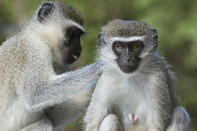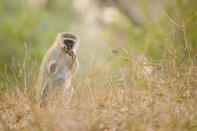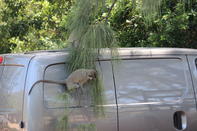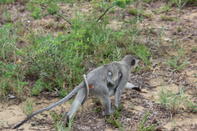Pretty Faced

Vervet monkeys are almost exclusively the only monkey found in the Lowveld, there may still be a few isolated patches where Samango monkey are found but these are rare. Vervets are attractive monkeys with an all grey pelage and striking black faces.
The fur fringing the face is tinged white to highlight the facial expressions during social encounters. A vervet monkey wishing to intimidate another will raise its brow to reveal the white eyelids which contrast sharply with the black face conveying an unmistakable message to the recipient.
Heads and Tails

Vervet monkeys have eyes, which face forward and the fields of vision overlap to enable them to gauge depth and distance. This is known as binocular vision and is imperative for a lifestyle that involves jumping between branches of trees. Vervet monkeys have very sharp canines to use as weapons of defence and aggression or as tools to forage.
The teeth are kept sharp because the edge of the upper canines occludes to the edge of the lower premolars and every action of the teeth refines the cutting surface. Vervet monkeys have long tails, which are important instruments of balance.
The tail helps to steady the monkey during leaps through the branches of a tree and assists with balance when they run along vertical branches. The tail is prehensile meaning it can be used to grip things and acts as an additional limb while the monkey moves and forages in precarious positions in the trees.
Climbing Aids

Vervets have hands with dexterous digits and opposable thumbs which facilitate grip when climbing and jumping in trees and also the manipulation of food objects.
They also use their fingers adeptly when allo-grooming one another’s fur fingering through the pelage of a troop mate and deftly removing bits of dead skin, salt and ectoparasites. Vervets have long whiskers which are tactile sensory organs and assist them with navigating around trees.
Baby Care

Babies are carried clinging to the mother’s stomach and chest. The paired mammary glands are situated between the front legs and the baby can conveniently suckle while in transit.
Babies are looked after by all the females in a troop including younger members and any and all members of the troop will rush to its defence if it is threatened.
By Megan Emmett